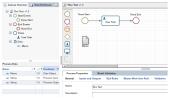Process Canvas
The process canvas provides a place to drag and drop shapes from the Shape Palette, and arrange them into a sequence flow. The Shape palette is located on the left edge of the canvas but can be repositioned. As you add shapes and data objects to the canvas they are added to an expanding list in the Canvas Overview tab on the left side. The Process Data section is located on the left side below the Canvas Overview and Data Dictionary. It contains a list of process inputs and outputs and data objects placed on the canvas.
Process Properties Tab
General Tab
The general tab contains the shape name and description.
| Field | Description |
|---|---|
| Name |
The shape name. Note: External shape names on the canvas may be repositioned. |
| Description | Additional information to clarify context. |
See Configuring General Options.
Inputs and Outputs
Data objects are associated with the process input and output to bring data in and out of the process.
| Field | Description |
|---|---|
| Name | The name of the data object. |
| Version | An iteration of the data object, i.e. 1.2. |
| Data Type | The format of stored values. |
| Value Set | A list of values from a value group. |
| Input | A check box when marked, associates the data object as an input to the process. |
| Output | A check box when marked, associates the data object as an output of the process. |
SLA Rules Tab
The SLA Rules Editor allows you to set up rules that define the amount of time to pass before a process is considered to be in jeopardy, or at risk of not being completed within the specified time interval.
| Field | Description |
|---|---|
| Priority | An .ordinal number which describes the numerical position of the sequence flow, e.g., first, second, third . |
| Active | Indicates shape is in use or not. |
| Name | Name of the rule. |
| Description | Additional information to clarify context. |
See Configure User Task SLA Rules
Master Work Item Rule tab
The master work item Rule tab allows you to configure a connection with a workflow master work item.
| Field | Description |
|---|---|
| Node | Nodes represent the operational and reporting structure of a business. Nodes provide the organizational backbone for of the workflow, such as rules, security, reporting and work item routing. |
| Item Type | An item type defines the type of work a user may do. |
| Sub Type | A subtype gives additional context to the type of transaction represented by the work item. A subdivision of item type. |
| Queue | A data structure that holds work awaiting processing by operators. |
| Business Calendar | Defines working and non-working days for an organization. XTRAC provides some predefined holiday sets, e.g. US Holidays, New York Stock Exchange Holidays, UK Holidays, Canadian Holidays, and India Holidays. |
| Field | Data entry locations that appear as input boxes in a work item. |
| Type | A type characterizes a value and constrains what values are valid. For example, a text type consists mainly of alphabetical letters, numbers and a set of special characters, a number type constrains valid values to digits 0-9 and a few other characters, a date type has a specific format of month day and year in a specific order. |
| Length | The number of letters, numbers or symbols a field is able to store. |
| Mask | A set of rules used to govern what a user is allowed to enter in as input in a text box. |
Validation
The Run Validation command on the Process menu lets you run a validation check at any time so you can address problems that may arise before you check in the process. The validation returns warning messages that indicate what needs to be fixed before the model can be checked in. The validation checks against the following:
| Field | Description |
|---|---|
| Data Versioning |
Checks the Data Dictionary for data object updates |
| BPMN |
Verifies that the model conforms to BPMN standards. |
| Configuration |
Ensures that process data elements have been configured correctly in the model. |
See Validating a Process Model
Shape Validation Tab
Shape property validation checks that data conforms to all input criteria, i.e. valid characters. Validation messages include the following:
| Field | Description |
|---|---|
| Warnings |
Indicate failed validation checks against BPMN and the fix required before the process may be deployed. Note: Models that fail validation can still be checked in but cannot be deployed. |
| Information |
May appear after validation checks of the data objects. For example, if you used a data object called "Salary" but a newer version exists, an information message tells you there is an updated version available. Note: These messages do not stop check in or deployment. You may continue to use the older version of the data object. |
Model Validation Tab
Model validation:
- Checks for master work item input data mappings.
- Verifies proper sequence flow connections.
- Lists information and warnings about the model configuration.
XTRAC Community |

|


